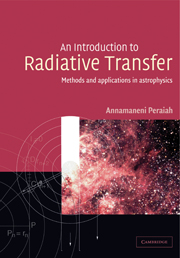Book contents
- Frontmatter
- Contents
- Preface
- Chapter 1 Definitions of fundamental quantities of the radiation field
- Chapter 2 The equation of radiative transfer
- Chapter 3 Methods of solution of the transfer equation
- Chapter 4 Two-point boundary problems
- Chapter 5 Principle of invariance
- Chapter 6 Discrete space theory
- Chapter 7 Transfer equation in moving media: the observer frame
- Chapter 8 Radiative transfer equation in the comoving frame
- Chapter 9 Escape probability methods
- Chapter 10 Operator perturbation methods
- Chapter 11 Polarization
- Chapter 12 Polarization in magnetic media
- Chapter 13 Multi-dimensional radiative transfer
- Symbol index
- Index
Chapter 10 - Operator perturbation methods
Published online by Cambridge University Press: 05 June 2012
- Frontmatter
- Contents
- Preface
- Chapter 1 Definitions of fundamental quantities of the radiation field
- Chapter 2 The equation of radiative transfer
- Chapter 3 Methods of solution of the transfer equation
- Chapter 4 Two-point boundary problems
- Chapter 5 Principle of invariance
- Chapter 6 Discrete space theory
- Chapter 7 Transfer equation in moving media: the observer frame
- Chapter 8 Radiative transfer equation in the comoving frame
- Chapter 9 Escape probability methods
- Chapter 10 Operator perturbation methods
- Chapter 11 Polarization
- Chapter 12 Polarization in magnetic media
- Chapter 13 Multi-dimensional radiative transfer
- Symbol index
- Index
Summary
Introduction
The complete linearization method of Auer and Mihalas (1969) was a significant advance in solving complex problems of radiative transfer and was followed by the work of Rybicki (1971), Kalkofen (1974) and others. These are basically Newton–Raphson linearization methods which are highly efficient but are not favourably oriented towards computer time and storage. Certain problems such as those which involve radiation hydrodynamics require faster methods with sometimes a little loss of accuracy. Operator perturbation techniques were developed to meet the needs of these problems. An excellent survey of these methods is given in Kalkofen (1987).
Wu (1992) developed a method that can deal with complex models with a high rate of convergence in multi-level non-LTE line formation calculations. It essentially consists of linearization of the transfer equation and constraints, then solving them separately. It overcomes the disadvantage of requiring the simultaneous solution of the corresponding equations by the complete linearization method and the poor convergence rate. Hubený and Lanz (1992) suggested two approaches to accelerate the method of complete linearization. The first one is the so called Kantorovich variant of the Newton–Raphson method by which the Jacobi matrix of the system is fixed. This reduces the calculation of the number of matrix inversions considerably and retains them fixed during the subsequent computations. The second approach is the application of Ng acceleration. These approaches reduce the computer time by about 2–5 times.
Information
- Type
- Chapter
- Information
- An Introduction to Radiative TransferMethods and Applications in Astrophysics, pp. 330 - 361Publisher: Cambridge University PressPrint publication year: 2001
